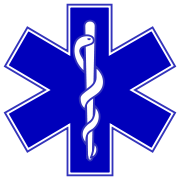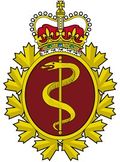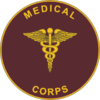Rod of Asclepius

The rod of Asclepius (⚕; sometimes also spelled Asklepios or Aesculapius), also known as the asklepian,[1] is an ancient symbol associated with astrology, the Greek god Asclepius, and with medicine and healing. It consists of a serpent entwined around a staff. The name of the symbol derives from its early and widespread association with Asclepius, the son of Apollo, who was a practitioner of medicine in ancient Greek mythology. His attributes, the snake and the staff, sometimes depicted separately in antiquity, are combined in this symbol.[2] The Rod of Asclepius also represents the constellation Ophiuchus (or Ophiuchus Serpentarius), considered by some to be the thirteenth sign of the sidereal zodiac. Hippocrates himself was a worshipper of Asclepius.[3]
Contents |
Symbolism
The serpent and the staff appear to have been separate symbols that were combined at some point in the development of the Asclepian cult.[4] The significance of the serpent has been interpreted in many ways; sometimes the shedding of skin and renewal is emphasized as symbolizing rejuvenation [5], while other assessments center on the serpent as a symbol that unites and expresses the dual nature of the work of the physician, who deals with life and death, sickness and health.[6] The ambiguity of the serpent as a symbol, and the contradictions it is thought to represent, reflect the ambiguity of the use of drugs[7], which can help or harm, as reflected in the meaning of the term pharmakon, which meant "drug", "medicine" and "poison" in ancient Greek[8]; we know that today antidotes and vaccines are often compounded from precisely the thing that caused the poisoning or illness. Products deriving from the bodies of snakes were known to have medicinal properties in ancient times, and in ancient Greece, at least some were aware that snake venom that might be fatal if it entered the bloodstream could often be imbibed. Snake venom appears to have been 'prescribed' in some cases as a form of therapy.[9]
The staff has also been variously interpreted. One view is that it, like the serpent, "conveyed notions of resurrection and healing", while another (not necessarily incompatible) is that the staff was a walking stick associated with itinerant physicians.[10] Cornutus, a philosopher probably active in the first century CE, in the Theologiae Graecae Compendium (Ch. 33) offers a view of the significance of both snake and staff that is worth quoting at length:
| “ | Asclepius derived his name from healing soothingly and from deferring the withering that comes with death. For this reason, therefore, they give him a serpent as an attribute, indicating that those who avail themselves of medical science undergo a process similar to the serpent in that they, as it were, grow young again after illnesses and slough off old age; also because the serpent is a sign of attention, much of which is required in medical treatments. The staff also seems to be a symbol of some similar thing. For by means of this it is set before our minds that unless we are supported by such inventions as these, in so far as falling continually into sickness is concerned, stumbling along we would fall even sooner than necessary. | ” |
|
—Asclepius: A Collection and Interpretation of the Testimonies, Baltimore, 1945 |
||
In any case the two symbols certainly merged in antiquity as representations of the snake coiled about the staff are common. It has been claimed that the snake wrapped around the staff was a species of rat snake, Elaphe longissima.[11]
Astrological connection
The two symbols were also associated with astrology. Asclepius was so skilled in the medical arts that he was reputed to have brought patients back from the dead. For this, he was punished and placed in the heavens as the constellation Ophiuchus (meaning "serpent-bearer"). This constellation lies between Sagittarius and Scorpius.[12] In early Christianity, the constellation Ophiuchus was associated with Saint Paul holding the Maltese Viper.
Alternative theories of origin
There are alternative theories accounting for the origin and development of the rod of Asclepius as a symbol. Because it can be difficult to trace the ultimate origins of symbolism, it is possible that no single theory is correct to the exclusion of others.
Biblical
A similar symbol, Nehushtan, is mentioned in the Bible in the Book of Numbers (Numbers 21:6-9).
Then the LORD sent fiery serpents among the people, and they bit the people, so that many people of Israel died. And the people came to Moses and said, "We have sinned, for we have spoken against the LORD and against you. Pray to the LORD, that he take away the serpents from us." So Moses prayed for the people. And the LORD said to Moses, "Make a fiery serpent and set it on a pole, and everyone who is bitten, when he sees it, shall live." Moses made a bronze serpent and set it on a pole. And if a serpent bit anyone, he would look at the bronze serpent and live.[13]
Worm theory
It has been suggested that the symbol once represented a worm wrapped around a rod; parasitic worms such as the guinea worm (Dracunculus medinensis) were common in ancient times, and were extracted from beneath the skin by winding them slowly around a stick. According to this theory, physicians might have advertised this common service by posting a sign depicting a worm on a rod. However plausible, no concrete evidence in support of this theory has been adduced.[14]
Professional usage


A number of organizations and services use the rod of Asclepius as their logo, or part of their logo. These include:
- American Academy of Psychiatry and the Law
- American Hippocratic Registry
- American Medical Association
- American Medical Student Association
- American Osteopathic Association
- American Veterinary Medical Association
- Army Medical Department of the U.S. Army (AMEDD)
- Australian Medical Association
- British Royal Army Medical Corps
- Canadian Medical Association
- Canadian Forces Medical Service
- Royal Australian Army Medical Corps
- Star of Life, symbol of emergency medical services
- World Health Organization
- Australian Veterinary Association
- Malaysian Medical Council
- MedicAlert
- Pakistan Army Medical Corps
- United States Air Force Medical Corps
Comparison with the Caduceus

It is relatively common, especially in the United States, to find the caduceus, with its two snakes and wings, used as a symbol of medicine instead of the correct rod of Asclepius, with only a single snake. This usage is erroneous, popularised largely as a result of the adoption of the caduceus as its insignia by the US Army medical corps in 1902 at the insistence of a single officer (though there are conflicting claims as to whether this was Capt. Frederick P. Reynolds or Col. John R. van Hoff).[15][16]
The rod of Asclepius is the dominant symbol for healthcare professionals and associations in the United States. One survey found that 62% of healthcare professionals used the rod of Asclepius, while 76% of commercial healthcare organizations used the caduceus.[17]
The initial errors leading to its adoption and the continuing confusion it generates are well known to medical historians. The long-standing and abundantly attested historical associations of the caduceus with commerce, theft, deception, and death are considered by many to be inappropriate in a symbol used by those engaged in the healing arts.[16] This has occasioned significant criticism of the use of the caduceus in a medical context.
| “ | As god of the high-road and the market-place Hermes was perhaps above all else the patron of commerce and the fat purse: as a corollary, he was the special protector of the traveling salesman. As spokesman for the gods, he not only brought peace on earth (occasionally even the peace of death), but his silver-tongued eloquence could always make the worse appear the better cause. From this latter point of view, would not his symbol be suitable for certain Congressmen, all medical quacks, book agents and purveyors of vacuum cleaners, rather than for the straight-thinking, straight-speaking therapist? As conductor of the dead to their subterranean abode, his emblem would seem more appropriate on a hearse than on a physician's car. | ” |
|
—Stuart L. Tyson, "The Caduceus", in The Scientific Monthly[18] |
||
Standard representation
The rod of Asclepius has a representation on the Miscellaneous Symbols table of the Unicode Standard at U+2695 (⚕).
See also
- Aaron's rod
- Bowl of Hygieia
- Nehushtan
References
- ↑ Wilcox, Robert A; Whitham, Emma M (15 April 2003). "The symbol of modern medicine: why one snake is more than two". Annals of Internal Medicine. http://www.annals.org/cgi/content/full/138/8/673. Retrieved 2007-06-15.
- ↑ See for example Pausanias, Description of Greece 2.26.1-28.1 (here translated by Jones) 2nd A.D.: "The image of Asklepios is, in size, half as big as Zeus Olympios at Athens, and is made of ivory and gold. An inscription tells us that the artist was Thrasymedes, a Parian, son of Arignotos. The god is sitting on a seat grasping a staff; the other hand he is holding above the head of the serpent."
- ↑ http://www.endicott-studio.com/rdrm/forcaduc.html
- ↑ Stephen Lock, John M. Last, George Dunea, The Oxford Illustrated Companion To Medicine, 2001, p261 "In early statues of Asclepius the rod and serpent were represented separately."
- ↑ "Asklepios' reptile was a healing creature: in ancient mythology the snake, whose skin was shed and rejuvenated, symbolized eternity and restoration of life and health" Albert R. Jonsen, The New Medicine and the Old Ethics, Harvard University Press, 1990, p122; this interpretation was current in Antiquity, as can be seen in an account of Apollodorus: "your marvel at the serpent curling around him and say that it is the symbol of the healing art, because just as the serpent sloughs the skin of old age, so the medical art releases from illness." (in E. Edelstein and L. Edelstein (eds.), Asclepius: A Collection and Interpretation of the Testimonies, Baltimore, 1945, p12)
- ↑ "[...] the ancient conception of the serpent as the embodiment of the mystery of one absolute life of the earth, which entails a continual dying and resurrection [...] the combination of corruption and salvation, of darkness and light, of good and evil in the Asklepian symbol." Jan Schouten, The Rod and Serpent of Asklepios, Symbol of Medicine, 1967, p2
- ↑ Albert R. Jonsen, The New Medicine and the Old Ethics, Harvard University Press, 1990, p122-123
- ↑ Henry E. Sigerist, A History of Medicine, Oxford University Press, 1987, p27-28
- ↑ James A. Kelhoffer, Miracle and Mission, Mohr Siebeck, 2000, p438-439 "[...] it was known, at least by some people in antiquity, that a snake's venom is not harmful if imbibed, but rather only if it enters directly into a person's blood stream. For example, the first-century CE historian Lucan writes that the younger Cato, when leading his troops through Libya during the Roman Civil War, informed his men about this very point [...] 'The poison of snakes is only deadly when mixed with the blood; their venom is in their bite, and they threaten death with their fangs. There is no death in the cup.'" He also mentions an account of Cornelius Celsus (first century CE) "'For a serpent's poison, like certain hunter's poisons..., does no harm when swallowed, but only in a wound'". "Likewise, Galen relates a rather peculiar healing by Asclepius involving viper's venom. The god appeared to a wealthy man in Pergamum and prescribed 'that he should drink every day of the drug produced from the vipers and should anoint the body from the outside.' [...] The elder Philostratus describes a similar practice of 'the wise Asclepiads,' who 'heal the bites of venomous creatures... using the virus itself as a cure of many diseases.'"
- ↑ Andre Menez, The Subtle Beast, Snakes From Myth to Medicine, 2003, p14
- ↑ Gerald David Hart, Martin St. J. Forrest, Asclepius: The God of Medicine, 2000, p42
- ↑ Brady, Bernadette (1999). Brady's Book of Fixed Stars. Weiser Books. ISBN 1-57863-105-X.
- ↑ [1].
- ↑ Emerson, John (July 2003). Eradicating Guinea worm disease: Caduceus caption. Social Design Notes. http://www.backspace.com/notes/2003/07/27/x.html. Retrieved 2007-06-15.
- ↑ F.H. Garrison, "The Use of the Caduceus in the Insignia of the Army Medical Officer", in Bull. Med. Lib. Assoc. IX (1919-20), 13-16
- ↑ 16.0 16.1 Engle, Bernice (Dec 1929). "The Use of Mercury's Caduceus as a Medical Emblem"". The Classical Journal 25 (1): 205.
- ↑ Friedlander, Walter J (1992). The Golden Wand of Medicine: A History of the Caduceus symbol in medicine. Greenwood Press. ISBN 0-313-28023-1.
- ↑ Tyson, Stuart L. "The Caduceus". Scientific Monthly 34 (6): 495.